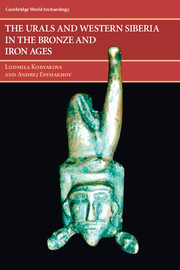Book contents
- Frontmatter
- Contents
- List of Plates, Figures, and Tables
- Foreword, by Philip L. Kohl
- Preface
- Introduction
- PART ONE THE BRONZE AGE: THE RISE OF ECONOMIC AND CULTURAL COMPLEXITY
- PART TWO THE IRON AGE – FORMING EURASIAN INTERACTIONS
- 5 The Transition to the Iron Age and New Tendencies in Economic Development
- 6 The Southern Urals within the Nomadic World: at the Cultural Crossroads
- 7 The World of Cultures of Cis-Urals Forest Zone of Eastern Europe: the Maintenance of Cultural Identities
- 8 The Forest-Steppe Cultures of the Urals and Western Siberia: on the Northern Periphery of the Nomadic World
- 9 Social Trends in North-Central Eurasia During the Second and First Millennia bc
- Notes
- References
- Index
5 - The Transition to the Iron Age and New Tendencies in Economic Development
from PART TWO - THE IRON AGE – FORMING EURASIAN INTERACTIONS
Published online by Cambridge University Press: 03 February 2010
- Frontmatter
- Contents
- List of Plates, Figures, and Tables
- Foreword, by Philip L. Kohl
- Preface
- Introduction
- PART ONE THE BRONZE AGE: THE RISE OF ECONOMIC AND CULTURAL COMPLEXITY
- PART TWO THE IRON AGE – FORMING EURASIAN INTERACTIONS
- 5 The Transition to the Iron Age and New Tendencies in Economic Development
- 6 The Southern Urals within the Nomadic World: at the Cultural Crossroads
- 7 The World of Cultures of Cis-Urals Forest Zone of Eastern Europe: the Maintenance of Cultural Identities
- 8 The Forest-Steppe Cultures of the Urals and Western Siberia: on the Northern Periphery of the Nomadic World
- 9 Social Trends in North-Central Eurasia During the Second and First Millennia bc
- Notes
- References
- Index
Summary
This chapter gives an overview of the problem of the introduction of iron and its development in the area that covers the vast space of the forest and forest-steppe of eastern Europe and western Siberia.
In respect to raw materials, throughout the territory in question there are numerous iron ore deposits. However, they differ in quality, mineral composition, and context of deposition. The richest ores are deposited in the mountain regions such as the Ural and Altai, where the content of soluble iron reaches up to 60–70 percent; the poorest ores are in the forest areas of eastern Europe and western Siberia, where the iron concentration does not exceed 45 percent (Kolchin 1953; Zinyakov 1997). When dealing with various types of raw materials, the ancient smelters had to know how to find, extract, and process different types of ores.
The problem of iron introduction has several aspects: (1) chronological, (2) technological, and (3) socioeconomic. We will try to touch on all of these, but, perhaps, not all of them will be fully analyzed.
The epoch of Iron is richly represented by various and numerous archaeological sites, the study of which has allowed scholars to show the extraordinary importance of this period in human history. It is commonly accepted that the historical development was a result of technological advances that were brought about, first of all, by the invention of a ferrous industry.
- Type
- Chapter
- Information
- The Urals and Western Siberia in the Bronze and Iron Ages , pp. 187 - 202Publisher: Cambridge University PressPrint publication year: 2007



